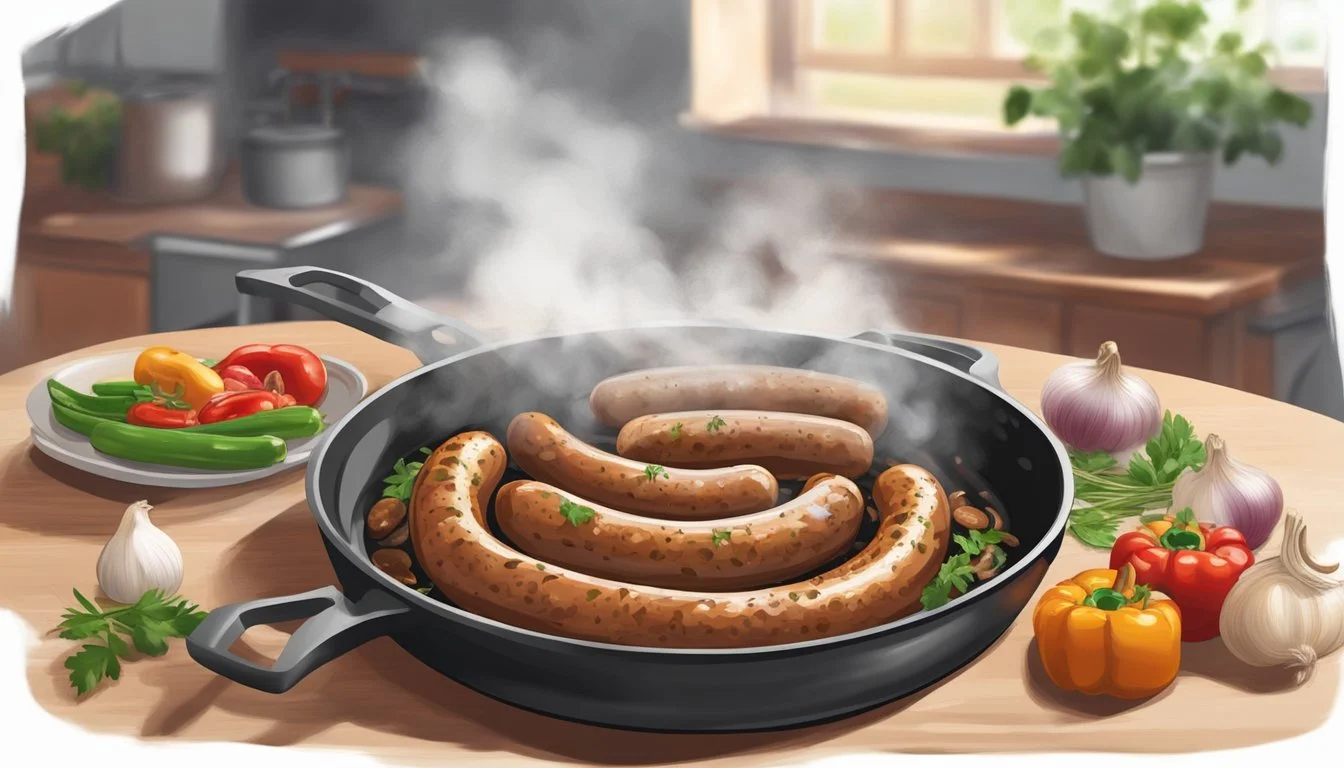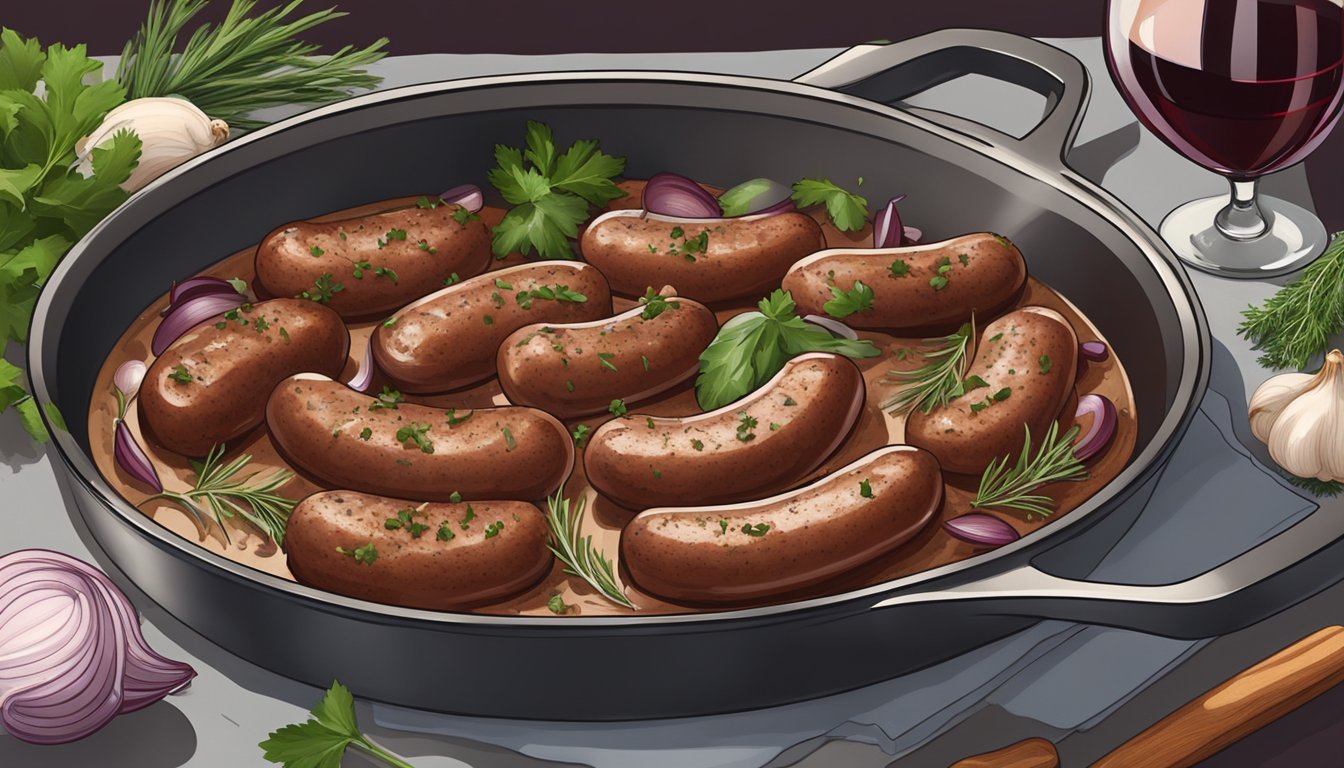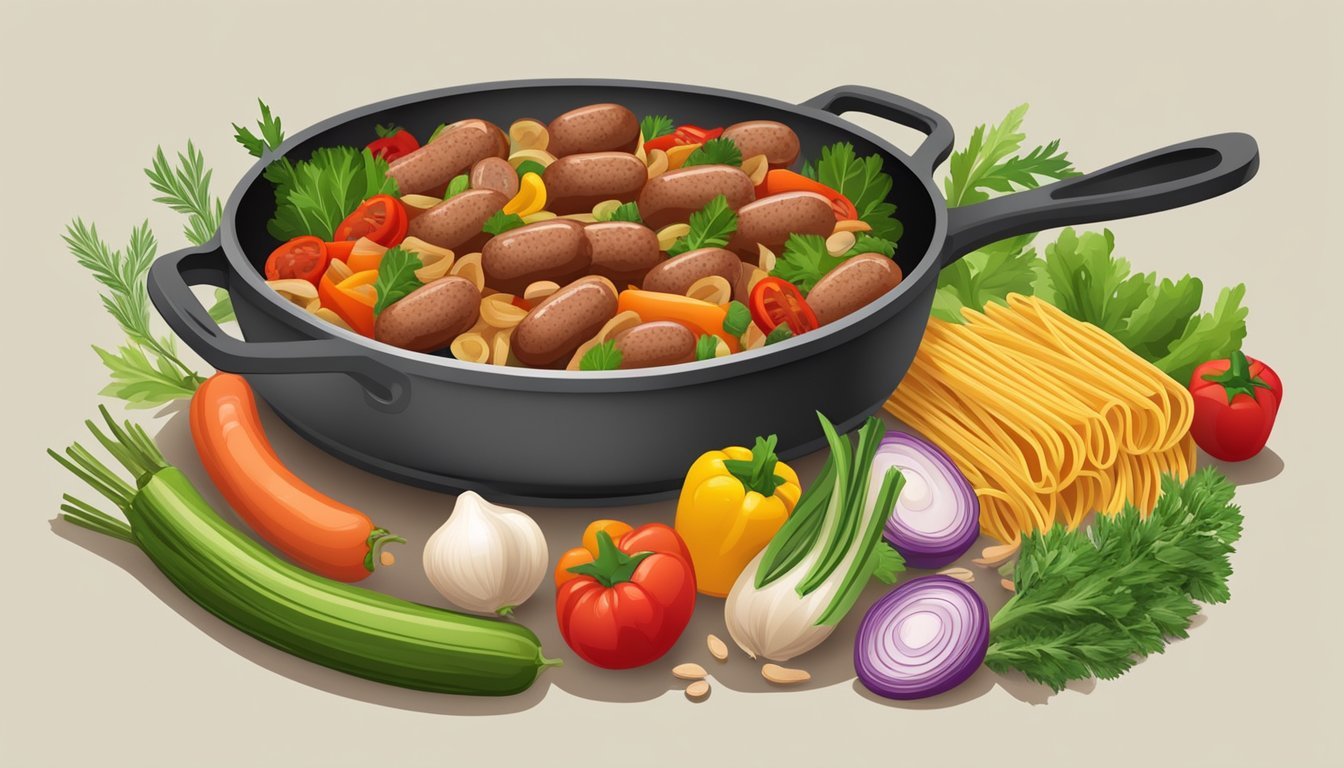How to Cook Italian Sausage
From Stovetop to Oven
Italian sausage is a versatile and flavorful ingredient that can elevate any meal. From classic pasta dishes to hearty sandwiches, this savory meat adds depth and richness to countless recipes. Cooking Italian sausage is simple and can be done using various methods, including stovetop frying, oven baking, grilling, or simmering.
Whether you prefer hot or sweet varieties, the key to perfectly cooked Italian sausage lies in achieving a crispy exterior while maintaining a juicy interior. The cooking method you choose depends on your desired outcome and the dish you're preparing. Stovetop frying offers quick results, while oven baking allows for a hands-off approach. Grilling imparts a smoky flavor, and simmering works well for incorporating sausage into sauces or soups.
By mastering these cooking techniques, you'll be able to prepare delicious Italian sausage dishes that will impress family and friends. From classic sausage and peppers to innovative recipes, the possibilities are endless when it comes to incorporating this flavorful ingredient into your culinary repertoire.
Types of Italian Sausage
Italian sausages come in a variety of flavors and spice levels, each offering a unique taste experience. The most common types are sweet, hot, and mild, with regional specialties adding diversity to this popular meat product.
Sweet Italian Sausage
Sweet Italian sausage, also known as dolce, is characterized by its mild flavor and subtle sweetness. It typically contains pork, fennel seeds, and garlic. The fennel provides a distinct anise-like taste.
This variety often includes other herbs such as basil or oregano. Sweet Italian sausage is versatile and works well in pasta dishes, on pizza, or grilled with peppers and onions.
Some producers offer chicken or turkey versions for those seeking leaner options. These alternatives maintain a similar flavor profile while reducing fat content.
Hot Italian Sausage
Hot Italian sausage, or piccante, packs a spicy punch. It's made with pork and seasoned with red pepper flakes, giving it a fiery kick. Garlic and fennel seeds are also common ingredients.
The heat level can vary between brands, ranging from mildly spicy to intensely hot. This variety adds zest to dishes like soups, stews, and spicy pasta sauces.
For those who enjoy heat but prefer poultry, some manufacturers produce hot chicken sausages. These maintain the spiciness while offering a different flavor base.
Mild Italian Sausage
Mild Italian sausage strikes a balance between sweet and hot varieties. It contains similar herbs and spices to sweet sausage but in more subdued quantities. Fennel is often present, but not as prominently as in sweet sausage.
This type is ideal for those who want flavor without sweetness or heat. It's a popular choice for sausage and peppers sandwiches or as a pizza topping.
Mild Italian sausage can be found in pork, chicken, and turkey variations. Each offers a slightly different taste while maintaining the classic mild flavor profile.
Other Varieties
Italy boasts numerous regional sausage varieties. Luganega is a long, thin sausage flavored with Parmigiano-Reggiano cheese. Cotechino is a large, fatty sausage often served on New Year's Eve.
Abruzzo liver sausage incorporates pork liver, heart, and lungs with unique seasonings like orange peel and bay leaves. Lazio's coriander sausage features sweet chili peppers and red wine.
These specialty sausages showcase Italy's diverse culinary traditions. They offer adventurous eaters a chance to explore authentic regional flavors beyond the standard sweet, hot, and mild options.
Selecting Ingredients
Choosing quality ingredients is crucial for a delicious Italian sausage dish. The right sausage, complementary vegetables, and flavorful additions elevate the meal.
Sausage Selection
Sweet Italian sausage is a popular choice for many recipes. Look for sausages made from high-quality pork with visible fat marbling. The casings should be intact and free from blemishes. Raw sausages offer more flexibility in cooking methods.
Check the label for key spices like fennel and anise, which give Italian sausage its distinctive flavor. Some varieties may include red pepper flakes for a spicy kick.
When cooking, aim for an internal temperature of 160°F (71°C) to ensure food safety.
Vegetable Pairings
Bell peppers are classic companions for Italian sausage. Red, yellow, and green peppers add vibrant color and sweetness. Slice them into strips or chunks before cooking.
Onions provide depth of flavor. Red onions offer a milder taste and attractive purple hue. Slice them thinly or cut into wedges.
Cherry tomatoes burst with juicy flavor when cooked alongside sausage. Whole or halved, they create a light sauce as they break down.
Additional Ingredients
Olive oil is essential for sautéing vegetables and preventing sausages from sticking. Choose extra virgin for best flavor.
Garlic cloves, minced or sliced, add aromatic depth. Use 2-3 cloves per pound of sausage.
Italian seasoning blend contains dried herbs like basil, oregano, and thyme. It quickly adds authentic flavor to the dish.
For extra umami, consider adding sliced mushrooms or a splash of red wine to the pan.
Preparation Techniques
Properly preparing Italian sausage enhances its flavor and ensures optimal cooking results. Key steps include careful handling, seasoning, and marinating to bring out the best in this versatile ingredient.
Prepping the Sausage
Start by removing the sausage from its packaging and patting it dry with paper towels. If cooking whole links, prick the casings with a sharp knife or fork to prevent bursting during cooking. For recipes requiring sliced sausage, use a sharp knife to cut links into even pieces, typically 1/2 to 1 inch thick.
Refrigerate sausage until ready to cook, keeping it at 40°F or below. Allow it to sit at room temperature for 15-20 minutes before cooking for more even heat distribution.
Seasoning and Marinating
Italian sausage comes pre-seasoned, but additional flavors can be added. Create a simple marinade with olive oil, minced garlic, salt, and black pepper. For bolder taste, include fennel seeds, red pepper flakes, or dried herbs like oregano and basil.
Marinate sausages for at least 2 hours or overnight in the refrigerator for deeper flavor penetration. Turn sausages occasionally to ensure even coating. Before cooking, remove excess marinade to prevent flare-ups when grilling or pan-frying.
For a quick flavor boost, brush sausages with marinara sauce during the last few minutes of cooking. This adds moisture and complements the sausage's inherent seasonings.
Cooking Methods
Italian sausage can be prepared using various techniques to achieve different flavors and textures. Each method offers unique benefits and results in a delicious meal.
Oven Baking
Preheat the oven to 375°F (190°C). Line a baking sheet with aluminum foil for easy cleanup. Place the sausages on the sheet, leaving space between each link.
Pierce the casings with a fork to prevent splitting. Bake for 25-35 minutes, turning occasionally. Use a meat thermometer to ensure the internal temperature reaches 160°F (71°C).
Baking produces evenly cooked sausages with a slightly crisp exterior. This method is ideal for cooking large batches with minimal hands-on time.
Grilling
Preheat the grill to medium-high heat, around 375°F (190°C). Place sausages directly on the grates, leaving space between each link.
Grill for 15-20 minutes, turning every few minutes to ensure even cooking and attractive grill marks. Check the internal temperature reaches 160°F (71°C).
Grilling imparts a smoky flavor and creates a crispy exterior. It's perfect for outdoor cooking and adds a charred taste to the sausages.
Pan-Frying
Heat a skillet over medium heat. Add a small amount of oil if desired. Place sausages in the pan, ensuring they don't touch.
Cook for 10-12 minutes, turning frequently to brown all sides. Use tongs to handle the sausages and avoid piercing the casings.
Pan-frying allows for easy monitoring and quick cooking. It's ideal for preparing sausage and peppers or adding to pasta dishes.
Stovetop Simmering
Place sausages in a large pot or deep skillet. Add enough water or tomato sauce to cover them halfway.
Bring the liquid to a simmer over medium heat. Cook for 10-12 minutes, turning occasionally. Remove sausages and brown in a separate pan if desired.
Simmering ensures thorough cooking and keeps the sausages moist. This method works well for incorporating sausages into sauces or soups.
Serving and Pairing
Italian sausage offers versatile serving options and pairs well with many foods. Its bold flavors complement a variety of dishes, from hearty mains to simple sandwiches and flavorful sides.
Main Course Combinations
Italian sausage shines as a main course ingredient. Slice it into rounds and toss with pasta for a quick, satisfying meal. Spaghetti and Italian sausage is a classic comfort food combination.
For a heartier dish, serve whole sausages over creamy polenta or risotto. The rich flavors blend beautifully with the creamy base.
Grilled sausages pair well with roasted vegetables like bell peppers, onions, and zucchini. This creates a balanced, colorful plate.
Sandwich and Sub Options
Italian sausage makes an excellent sandwich filling. Serve it on a crusty roll with sautéed peppers and onions for a traditional Italian sausage sub.
For a twist, try it on focaccia bread with melted provolone cheese and marinara sauce. This creates a pizza-like sandwich bursting with flavor.
A sausage and potato roll combines comfort foods in one handheld meal. Add mustard or your favorite condiments for extra tang.
Side Dishes
Light, crisp salads balance the richness of Italian sausage. Try a simple green salad with vinaigrette or a tangy Caesar salad.
Roasted potatoes complement the sausage's savory flavors. Season them with garlic and herbs for an aromatic side dish.
Grilled or sautéed vegetables make excellent sides. Caramelized onions add sweetness, while roasted bell peppers provide color and flavor.
For a bread option, serve garlic bread or bruschetta. The crunchy texture contrasts nicely with the juicy sausage.
Storage and Reheating
Proper storage and reheating techniques are crucial for maintaining the quality and safety of Italian sausages. These methods ensure optimal flavor and texture while preventing foodborne illness.
Storing Leftovers
Store cooked Italian sausages in an airtight container or wrap tightly in aluminum foil or parchment paper. Place in the refrigerator within 2 hours of cooking. Refrigerated sausages will keep for 3-4 days.
For longer storage, freeze cooked sausages. Wrap individual sausages in plastic wrap or aluminum foil, then place in a freezer bag. Remove as much air as possible before sealing. Label with the date and use within 2-3 months for best quality.
Thaw frozen sausages in the refrigerator overnight before reheating. Never thaw at room temperature, as this can promote bacterial growth.
Reheating Techniques
The oven method produces evenly heated sausages with a crisp exterior. Preheat the oven to 350°F (175°C). Place sausages on a baking sheet lined with parchment paper. Heat for 10-15 minutes, turning once halfway through.
For quicker reheating, use the microwave. Place sausages on a microwave-safe plate and cover with a damp paper towel. Heat in 30-second intervals, turning occasionally, until warmed through.
Pan-frying is another effective method. Heat a skillet over medium-low heat. Add a small amount of oil and cook sausages for 5-7 minutes, turning frequently, until heated to an internal temperature of 165°F (74°C).
Health and Nutrition
Italian sausage offers protein and flavor, but also contains significant fat and calories. Nutritional content varies based on ingredients and preparation methods.
Caloric Content
A 3-ounce serving of Italian sausage typically contains around 270 calories. Fat accounts for about 71% of these calories, with 22.9 grams of total fat per serving.
Protein content is substantial, usually around 14 grams per 3-ounce portion. This makes Italian sausage a good source of this essential macronutrient.
For those watching their calorie intake, chicken or turkey sausage alternatives are available. These options generally provide fewer calories and less fat while still offering protein.
A serving of buffalo-style skinless chicken sausage (85g) contains:
110 calories
7g total fat
13g protein
Dietary Considerations
Italian sausage is high in sodium, with some varieties containing up to 743mg per 100 grams. This is about 32% of the recommended daily value.
Fat content in Italian sausage is primarily saturated fat. Limiting saturated fat intake is important for heart health.
For those with dietary restrictions, there are alternatives:
Turkey sausage: Lower in calories and fat
Chicken sausage: Often leaner than traditional pork sausage
Plant-based sausages: Suitable for vegetarian or vegan diets
These alternatives can still provide flavor while reducing calorie and fat intake. However, it's important to check labels, as sodium content may remain high in some products.
Safety and Food Handling
Proper safety measures and food handling techniques are crucial when preparing Italian sausage. Following recommended cooking temperatures and maintaining kitchen hygiene helps prevent foodborne illnesses and ensures a safe, enjoyable meal.
Cooking Temperatures
Italian sausage must reach an internal temperature of 160°F (71°C) to be considered safe for consumption. This applies to all pork sausages, including Italian varieties. Using a meat thermometer is the most accurate way to check doneness.
Insert the thermometer into the thickest part of the sausage. If it reads 160°F (71°C) or higher, the sausage is fully cooked. For sausages containing ground turkey or chicken, the safe internal temperature is slightly higher at 165°F (74°C).
Avoid relying solely on visual cues. While color can provide some indication, it's not a foolproof method. Fully cooked sausage may appear pink inside, while undercooked sausage might look brown.
Kitchen Hygiene
Maintaining a clean kitchen environment is essential when handling raw Italian sausage. Always wash hands thoroughly with soap and warm water before and after touching raw meat.
Use separate cutting boards and utensils for raw sausage and other ingredients to prevent cross-contamination. Clean all surfaces, cutting boards, and utensils that come into contact with raw sausage using hot, soapy water.
Store raw Italian sausage in the refrigerator at 40°F (4°C) or below. Use within 1-2 days or freeze for longer storage. When thawing frozen sausage, do so in the refrigerator, not on the counter.
Cook sausages promptly after removing from refrigeration. Never leave raw sausage at room temperature for more than 2 hours. Following these practices helps minimize the risk of bacterial growth and foodborne illness.
Cooking Italian Sausage for Events
Italian sausage is a versatile crowd-pleaser for various gatherings. Its rich flavors and ease of preparation make it an excellent choice for feeding large groups. Proper planning and cooking techniques ensure delicious results that will satisfy guests at any event.
Family Gatherings
Italian sausage shines at family get-togethers. For indoor events, oven-roasting is a fuss-free method. Arrange sausages on a large baking sheet, leaving space between each link. Bake at 375°F for 25-30 minutes, turning once halfway through. This method yields crispy exteriors and juicy interiors.
For outdoor family barbecues, grilling is ideal. Preheat the grill to medium-high heat. Cook sausages for 15-20 minutes, turning every few minutes for even browning. Serve on a large platter with grilled peppers and onions for a classic combination.
When planning, estimate 1-2 sausages per adult and 1 per child. Prepare extra for leftovers. Slice cooked sausages and add to pasta salads or frittatas for next-day meals.
Sports and Outdoor Events
Tailgating and sports events call for portable, easy-to-eat options. Pre-cook sausages at home by simmering in beer or water for 10-12 minutes. This partially cooks the sausages and reduces grill time at the event.
At the tailgate, finish sausages on a portable grill for 5-7 minutes, turning frequently. Serve in buns with condiments on the side. For large groups, consider slow-cooking sausages with peppers and onions in a portable crockpot. This hands-off method keeps sausages warm throughout the event.
For outdoor picnics, cold sausage platters are convenient. Grill sausages ahead of time, chill, and slice. Arrange on a platter with cheese cubes, crackers, and mustard for easy snacking.
Creative Twists and Variations
Italian sausage lends itself well to experimentation and fusion with other cuisines. Innovative cooks can also adapt traditional recipes to accommodate dietary preferences and restrictions.
Fusion Dishes
Italian sausage pairs wonderfully with flavors from around the world. Try adding it to a spicy Thai curry for a unique East-meets-West dish. Incorporate it into Mexican-inspired dishes like quesadillas or enchiladas for a flavorful twist.
For a Mediterranean fusion, combine Italian sausage with Greek ingredients like feta cheese and olives in a hearty salad. Create an Italian-Indian mashup by using the sausage in a spiced biryani or as a filling for samosas.
Experiment with Asian-inspired dishes by adding sliced Italian sausage to stir-fries or fried rice. The sausage's rich flavor complements the bold seasonings used in many Asian cuisines.
Vegetarian and Vegan Alternatives
Plant-based alternatives to Italian sausage are increasingly popular. Many meat substitutes capture the texture and spices of traditional sausage without animal products.
Seitan, a wheat protein, can be seasoned with Italian herbs and spices to mimic sausage flavor. Lentils or mushrooms, when finely chopped and combined with appropriate seasonings, create a satisfying vegetarian sausage substitute.
For a homemade option, mix textured vegetable protein (TVP) with Italian herbs, garlic, and fennel seeds. Shape the mixture into patties or crumbles for use in various recipes.
Vegan versions of Italian sausage are available in many supermarkets. These products often use pea protein or soy as a base and can be used in traditional recipes as a direct substitute.




